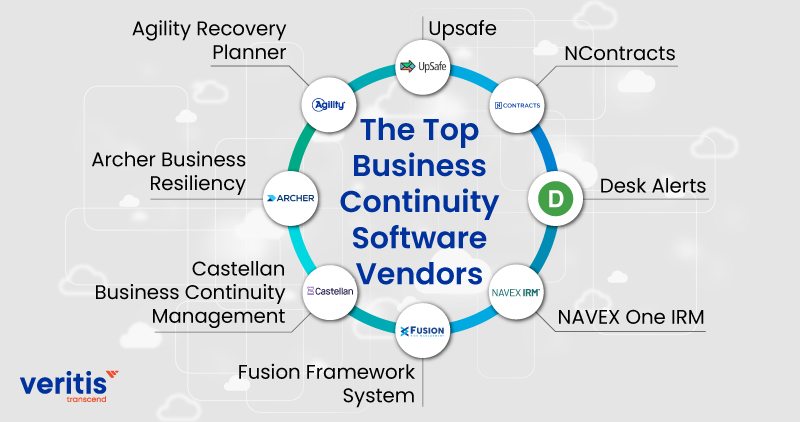
The concept of business continuity is to have a plan in place in case of emergencies or challenging circumstances. Both internal and external risks could apply to these circumstances. Under all situations, business operations must be uninterrupted.
After a protracted unexpected pause, getting a business back on track can be expensive. However, customers can feel more confident in your company’s ability to protect them if the flow of operations is maintained. And critical operations are kept running during and after a crisis.
Business continuity software is a collection of programs created to increase the accuracy and efficiency of BCP/BCM procedures, metrics, and compliance: business impact evaluations and the creation and revision of recovery plans. And the detection of holes in BCM programs is made possible by the business continuity program. These business continuity tools products automate the BCP/BCM process. It can purchase on-premise or through a SaaS model.
Software from vendors in this industry is made to assist businesses in running their BCM programs more effectively. BCM software can help organizations assess their vulnerability to internal and external threats. Let them respond to threats like natural disasters or data breaches and protect their commercial interests.
Business continuity planning software secures their data is accurate, complete, well organized, and analyzed. In addition, these solutions give visibility to organizations. And their BCM programs promote information sharing with senior management. And help companies quickly react to disruptions.
What is Business Continuity Management (BCM)?

BCM is the commitment to planning efficient responses to technical and operational risks that could threaten an organization’s ability to recover. When working in the office or remotely, your personnel must stick to a business continuity management system. So it will be the framework, program, or administrative structure.
This process requires in-depth planning, preparedness for unforeseen events, and guidance on continuing operations most effectively once the threat has passed.
The initial stages of continuity are awareness and prevention. That allows for the ongoing provision of essential services and goods to clients. However, not having a BCM program in place for your company entails three risks: increased expenses, reduced productivity, and prolonged downtime.
Critical Risks for Business Continuity Solutions
A company must identify and list potential internal or external risks as part of the continuity management process. It is all about a business continuity solutions plan, or BCP. A BCP will include tools, guidelines, and information to teach workers how to handle complex cases.
- Mistakes in communication
- Illnesses and injuries
- Weather risks
- A corporation is subject to ransomware attacks every 40 seconds from insiders and outsiders.
- Failure of the file backup process: Ensure that all relevant files are backed up in one location so that you can locate them quickly if you need to transfer them.
- Have a plan outlining what to do if your firm experiences a data breach involving a hacker attempting to access critical information in your organization’s files.
- How to handle or fix human errors, such as when a worker mistakenly unplugs a wire or makes a typo in the code that stops operations for the entire day.
- Protect your customers’ names, addresses, social security numbers, and other personal information.
Useful link: 4 Core Principles For A ‘Perfect Business Continuity Plan’
The Top Business Continuity Software Vendors

Companies can prepare for and recover from disasters with the help of multiple highly regarded BCM software solutions that different vendors offer. As a result, these platforms rank among the most prominent in their field.
1) Agility Recovery Planner
The software program Agility Recovery Planner provides a complete business continuity planning software package. In addition, it helps firms in remaining compliant with BCM specifications.
This flexible software accommodates companies of all sizes and sectors and can customize to meet each one’s unique needs. It helps with multiple tasks, including executing business impact evaluations. The other tasks are risk assessments, managing continuity plans, and completing compliance reporting requirements.
Companies employing BCP plans can use the Recovery Planner software suite. Agility software enables cross departmental communication and simplifies the data collection process. Additionally, it prioritizes operational methods. Which makes it simple for companies to update plans, manage crucial vendors, and deal with crises more effectively.
2) Archer Business Resiliency
The BCM system from Archer Business Resiliency combines continuity planning for operations, IT disaster recovery, crisis management, and incident recovery services with the organization’s overall business objectives. In addition, the vendor places a high priority on automation. As a result, they allow clients to react swiftly to outages and coordinate rescue operations in emergencies.
3) Castellan Business Continuity Management
Castellan Solutions makes Castellan Business Continuity Management with seamless integration into daily operations. In addition, they are explicitly focusing on automation. The solution combines system integration, program governance, and automation tools to deliver powerful BCM capability. Additionally, the platform prioritizes security with elements like single sign-on support. And also multi-factor authentication (MFA) and compliance with data security regulations.
Castellan is a BCM solution that helps with planning, strategy, testing, and analyses of business impact and risk management. In addition, the platform’s configurable dashboard and reporting features help identify areas that require disaster vigilance improvement.
Castellan offers mobile incident support, emergency notifications, and communication options. And also crisis dashboards to help with command-and-control activities during events.
4) Fusion Framework System
Fusion Risk Management makes the Fusion Framework System seamlessly interact with leading software programs such as Salesforce and ServiceNow. The system enables two-way communication with multiple third-party applications and prebuilt connections to provide emergency notice and response for crucial workflows. In addition, fusion’s Community Connector simplifies establishing connections between clients, partners, and staff members. And enhancing the management of operational interruption risks.
Context mapping tools are another component of the platform that aids in helping firms. It comprehends how they carry out crucial workflows and operations in business continuity plans.
Useful link: Steps to Preserve Business Continuity and Enterprise Resilience
5) NAVEX One IRM
The BCM system, also known as Lockpath, has been incorporated into the Integrated Risk Management solution of the NAVEX One Platform. This platform offers a lot of components to recognize and resolve third-party risks. In addition, it develops an automated risk assessment system and monitors compliance requirements, offering a thorough approach to BCM concerns within the integrated risk management framework.
NAVEX suggests its clients study its primary Integrated Risk Management questionnaire online before starting the BCM process. This survey estimates a company’s preparation and situation regarding working with outside risk managers and planning for business continuity solutions. NAVEX One promises to be a user-friendly proactive platform that improves the visibility of continuity and risks. While decreasing daily operational management expenses and releasing technical staff time. Customized APIs are available for selection and application as required.
6) Desk Alerts
This dependable internal communications solution makes it simple to immediately connect with personnel during an emergency, including an IT issue. In addition, employees can instantly receive critical step-by-step instructions thanks to the system’s message capabilities, ensuring they know what to do.
7) NContracts
NContracts offers software and services that ensure the total integration of risk management and employee compliance in business continuity plans. The user can utilize various tools on its interactive dashboard, among other features, to determine where their company stands in each risk area.
8) Upsafe
Technology companies can manage their security programs with this all-in-one platform. In addition, the platform offers capabilities, including creating a strategy, adhering to predetermined rules, and earning certifications in particular fields. Where a firm would need extra help.
Conclusion
Despite the advantages of business continuity planning software, companies frequently need help with attempting to increase the agility of their BCP/BCM programs. A program’s ability to adjust to new challenges becomes more challenging the more complicated it is. It is also simpler to adjust at specific points than others because BCM programs have lifecycles.
Many businesses struggle to adapt to constantly shifting threat environments due to a lack of basic understanding of the BCM approach, BCM software, and optimal program components. BCM specialists advise companies to assess their needs and priorities before investing in a BCM system. Companies should also be aware of the effort required to implement the software and refrain from purchasing more than they require.
Veritis, the Stevie Award winner, has provided direction and cutting-edge solutions to startups and Fortune 500 enterprises. Contact us with your unique requirements, and we’ll develop solutions that meet your business goals.
Got Questions? Schedule A Call
Also Read:
- 5 Key Considerations for Choosing a Right M&A Advisory
- Guide to Digital Transformation Technologies and Their Business Impact
- Technology Advisory as Perfect Corporate IT Strategy
- 4 Core Principles For A ‘Perfect Business Continuity Plan’
- Business Continuity Planning: How C-suite Can Build Human Resilience?
- Business Continuity: Steps To ‘Restart’ Your Stalled Operations!